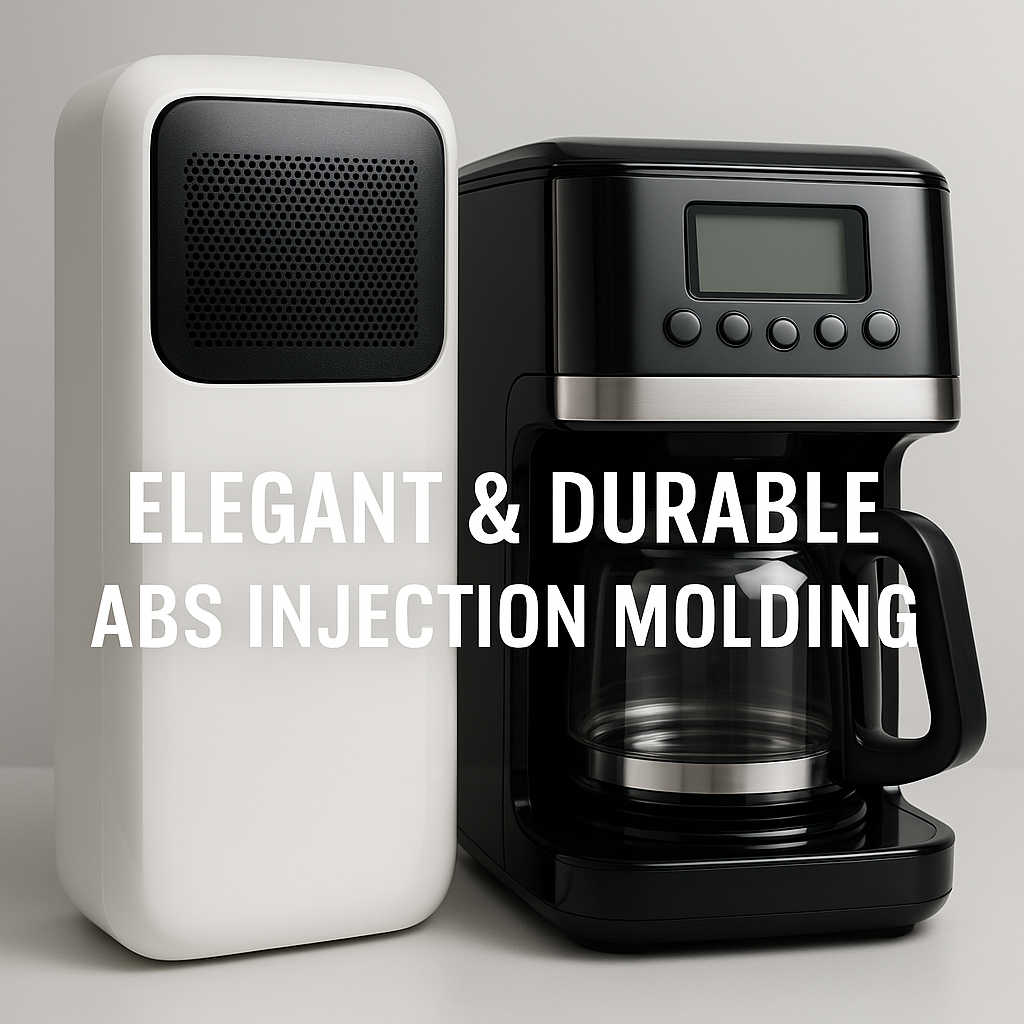Develop Consumer Appliances With ABS Injection Molding — Sturdy Durability Meets Elegant Aesthetics
Develop Consumer Appliances With ABS Injection Molding — Sturdy Durability Meets Elegant Aesthetics
From sleek air-purifiers and robot vacuums to smart coffee makers and premium rice cookers, today’s appliances must look as refined as high-end electronics while lasting through years of weekend chores. Acrylonitrile-Butadiene-Styrene (ABS) injection molding delivers that tough-yet-polished balance better than almost any other thermoplastic. Below is a design-through-manufacturing playbook that shows how you can harness custom ABS molding to create eye-catching, scratch-resistant, and cost-efficient consumer products.
1 Why ABS Is a Natural Fit for Modern Appliances
| Performance Vector | How ABS Excels | Practical Payoff |
|---|---|---|
| Impact Strength | Butadiene rubber phase absorbs drops & bumps | Survives countertop falls and shipping shocks |
| Surface Versatility | Accepts mirror-gloss, deep-grain textures, piano-black paints, metallic plating | Matches brand-specific finishes across product lines |
| Dimensional Stability | Low creep and shrink (≈ 0.6 %) | Snap-fit panels stay tight; lid seals remain flush |
| UV-Stable Variants | Custom light-fast masterbatches | Kitchen appliances stay white instead of yellowing |
| Cost Efficiency | 20–30 % lower resin cost than PC or PC/ABS | Frees BOM budget for Wi-Fi modules and premium UI components |
2 Designing ABS Parts for “Sturdy Meets Elegant”
-
Wall Thickness Keep between 2–3 mm (+ / – 15 %). Thinner walls risk show-through at ribs; thicker walls add weight and sink marks.
-
Ribs & Bosses Height ≤ 3 × wall; thickness ≈ 0.6 × wall. Chamfer root corners for better gloss.
-
Gloss vs. Texture
-
SPI A-2 / A-1 polish for mirror lids, indicator windows.
-
VDI 18–24 or MT-11000 texture hides flow lines on large panels.
-
-
Split Lines Route along styling features (e.g., grille vents) to make joints invisible.
-
Snap-Fit Tabs Use 0.5 – 0.7 mm under-cut and provide 1 ° draft for squeak-free assembly.
-
Logo & Icons Deboss 0.2 mm and polish to gloss; laser-etch after UV-cure paint for night-glow back-lighting.
3 Surface-Enhancement Options for Premium Appeal
| Method | Added Value | Notes |
|---|---|---|
| UV-Cure Piano-Black Paint | Deep gloss, scratch ≥ 3H | Mask gating zones to avoid flow lines |
| In-Mold Decoration (IMD) | Seamless graphics, metallic films | Requires IMD-grade ABS; temperature ≤ 240 °C |
| Vacuum Metallization | Chrome or brushed-steel look | Add ABS + PC for higher heat if cooking surface proximity |
| Soft-Touch TPE Over-Mold | Warm grip on handles, knobs | Tool two-shot or insert-mold on same press |
| Laser Texture (LDS Ready) | Matte micro-pattern that resists fingerprints | Combine with antimicrobial clear coat for hygienic surfaces |
4 Process Parameters for Consistent Cosmetics
| Control | Typical Window* | Cosmetic Impact |
|---|---|---|
| Melt Temp | 220 – 250 °C | Too low → flow lines; too high → yellow tint |
| Mold Temp | 60 – 80 °C | Higher temp = higher gloss + better weld-line strength |
| Injection Speed | Medium-High | Fills long ribs without flow hesitation |
| Pack/Hold Pressure | 90 % of peak | Removes sink on display bezels |
| Cooling Time | Moldflow-optimized | Cuts warpage; conformal cooling shortens cycle |
*Adjust for specific ABS grade and part geometry.
5 Typical Appliance Assemblies Molded in ABS
| Sub-Assembly | ABS Part | Finish Strategy |
|---|---|---|
| Countertop Air-Purifier | Outer shell, grille, latch | VDI 21 texture + laser logo |
| Smart Rice Cooker | Lid handle, control bezel | Piano-black UV paint + capacitive touch icons |
| Premium Air-Fryer | Basket knob, side panels | Soft-touch TPE over-mold on ABS core |
| Robot Vacuum | Bumper ring, dust-bin housing | High-gloss clear ABS with rear spray coat |
| Espresso Machine | Drip tray, water reservoir frame | Metallic vacuum plate + scratch-resistant clear |
6 Cost and Cycle-Time Case Study
Component: 2-piece ABS outer shell for smart humidifier
Weight: 210 g (front), 180 g (back)
Volume: 300 k sets/year
| Scenario | Cycle (s) | Scrap (%) | Cosmetic Rejects | Unit Cost USD |
|---|---|---|---|---|
| Commodity ABS | 32 | 3.5 | 2.8 % | 1.34 |
| High-Flow, UV-Stable ABS | 26 | 1.2 | 0.7 % | 1.18 |
Savings: US $48 k resin + US $36 k less scrap annually, while raising cosmetic yield.
7 Why Partner With TaiwanMoldMaker.com for ABS Appliance Projects?
-
Texture & Polishing Expertise — In-house SPI A-1/A-2 polish, EDM graining, and laser micro-textures.
-
Integrated Secondary Ops — Painting, IMD, vacuum metallization, and two-shot TPE available on-site.
-
Fast Resin Sampling — 300+ high-flow, UV-stable, and FR ABS grades stocked locally for < 1-week trials.
-
Bridge-to-Scale Program — Prototype aluminum tools credited toward multi-cavity P20/H13 production molds.
-
Data-Driven QA — Scientific molding windows locked with cavity-pressure sensors and CpK ≥ 1.67.
8 Action Plan—Turn Your Appliance Vision Into Production Reality
-
Define Surface & Structural Specs — gloss level, color target, drop-test rating.
-
Upload CAD & CTQ List to TaiwanMoldMaker.com for a 48-hour DFM and cost estimate.
-
Approve Tool Concept — gate locations, texture call-outs, and cooling strategy.
-
Prototype & Finish Trials — paint, plate, or over-mold on pilot parts in 2–3 weeks.
-
Lock Process Window — finalize cosmetic and mechanical validation (CpK, tumble, UV-aging).
-
Scale Production — release multi-cavity steel; launch with JIT delivery to your assembly line.
Key Takeaways
-
ABS delivers a rare balance of toughness, processability, and high-end aesthetics—perfect for consumer appliances.
-
Surface planning matters as much as structural design: polish, texture, and coatings define perceived quality.
-
Engage a full-service molder early to integrate DFM, tooling, finishing, and cost optimizations in one loop.
Ready to mold appliance parts that feel premium and last? Connect with TaiwanMoldMaker.com to access vetted ABS molding specialists and transform your designs into durable, elegant products that command shelf appeal and user loyalty.









